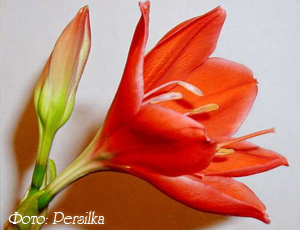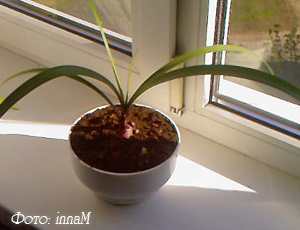Amaryllis family. Homeland - South Africa. The beautiful Vallota speciosa species is common in the culture. A beautiful perennial bulbous plant with flowers collected in an umbrella by flowers on a long peduncle. The leaves are dark green, reddish at the base, linear in shape up to 65 cm long and 3.5 cm wide, in comparison with amaryllis - narrower and thinner. Another difference between the vallota is that if you remove dry scales on the bulb, then the color of the bulb closer to the crown is pink. Usually forms many children. Vallota blooms in summer and autumn. There are varieties with bright red, pink, salmon flowers.


Vallota - home care
Temperature: Vallota is larger than a greenhouse plant - it requires a cool content of about 10-12 ° C in winter, at least + 7 ° C, so it is advisable to keep it at home in winter on an insulated balcony or fencing off the warm air of the room with a greenhouse film along the border of the windowsill. In this case, the dormant period in the vallot begins after the end of flowering and lasts about 2 months .
Lighting: Bright lighting, including direct sunlight in the morning or evening - shading will only be needed during midday hours in summer if the pot is on the south or south-west window. Although the east window is preferable for the vallot.
Watering: Plentiful from spring to autumn, the earthen lump should not dry completely into dust, or stick together in a monolith, but by the next watering it should have time to dry out in the upper third of the pot. In winter, the bulbs are watered very moderately, depending on the temperature, this can be once every 10-14 days, if about 20 ° C, once a month, if about 15 ° C or even less often.


Fertilizer: From March to October - until the end of flowering, fertilizer dressing is carried out after 2 weeks with special liquid fertilizers for flowering indoor plants, in doses recommended in the instructions. There are special fertilizers for bulbs or for amaryllis. The following fertilizers are suitable for her: "Biomaster for bulbous flowers," "Agricola for flowering," "Good power for bulbous flowers" and others.
Humidity: From time to time, the leaves of the wallot are wiped with a sponge. In summer, when the temperature is above 23-24 ° C, they are regularly sprayed so that water does not fall on the flowers .
Transplant: Once every 2-3 years, in the spring. Vallota blooms only when the pot is not too large or even cramped. The soil is nutritious: 1 part of the turf land, 1 part of the leaf or peat land, 1 part of the humus and 1 part of the coarse sand or vermiculite. They plant bulbs in shallow but wide pots, always with a good layer of drainage. If necessary, the wallot can replace the top layer of the earth if a white or reddish salt coating appears on it.
Reproduction: Daughter bulbs. During transplantation, the children are carefully separated and seated one by one on a small pot about 9-10 cm in diameter. Bulbs deepen only half. After landing, the first time is rarely watered. Separated children bloom only for 2-3 years.